As a local, I’m excited to take you on a journey through the city’s historic landmarks that reflect its rich cultural heritage. From grand antebellum mansions to quaint Creole cottages, our city’s architectural heritage is a testament to its history and the people who have shaped it.
Our architectural heritage in the south is a unique blend of styles, influenced by the city’s cultural melting pot. As we explore the various architectural styles and historic districts, you’ll discover the significance of preserving our cultural heritage.
Key Takeaways
- Explore the diverse architectural styles that define New Orleans’ historic architecture.
- Discover the city’s historic districts and their significance in preserving cultural heritage.
- Learn about the importance of preserving historic landmarks in New Orleans.
- Understand the role of architectural heritage in shaping the city’s identity.
- Experience the unique blend of cultural influences that have shaped New Orleans’ architecture.
The Rich History Behind New Orleans’ Architecture
The architecture of New Orleans is a living history, showcasing the city’s evolution under Spanish and French rule. As a local, I’ve always been fascinated by the way our buildings tell the story of our city’s complex past.
New Orleans’ unique cultural identity is deeply rooted in its history as a colonized city. The influences of European colonization are evident in our architectural styles, particularly in the French Quarter buildings, which are iconic representations of the city’s rich heritage.
Influences of European Colonization
European colonization played a significant role in shaping New Orleans’ architecture. The city’s strategic location made it a prized possession for both the French and Spanish empires. As a result, our buildings reflect a blend of these cultures, creating a distinct architectural identity.
The French brought their expertise in urban planning, designing the city’s famous grid pattern. Meanwhile, the Spanish contributed to the development of the city’s architectural styles, introducing ornate details and balconies that have become hallmarks of New Orleans’ buildings.
The Role of Spanish and French Styles
The interplay between Spanish and French styles is a defining characteristic of New Orleans’ architecture. The city’s architectural styles in Louisiana are a testament to this blend, with buildings showcasing elements like stucco facades, ironwork, and ornate decorations.
In the French Quarter, you’ll find iconic buildings that exemplify this mix of styles. The use of bright colors, intricate ironwork, and ornate balconies creates a visually stunning landscape that’s quintessentially New Orleans.
As we explore the history behind our architecture, it becomes clear that the city’s cultural identity is deeply intertwined with its built environment. The story of New Orleans is told through its buildings, and understanding this history is key to appreciating the city’s unique charm.
Iconic Architectural Styles Found in New Orleans
As you stroll through the historic districts of New Orleans, you’ll encounter a variety of iconic architectural styles that define the city’s unique character. The city’s architecture is a reflection of its complex history, influenced by various cultures and traditions.
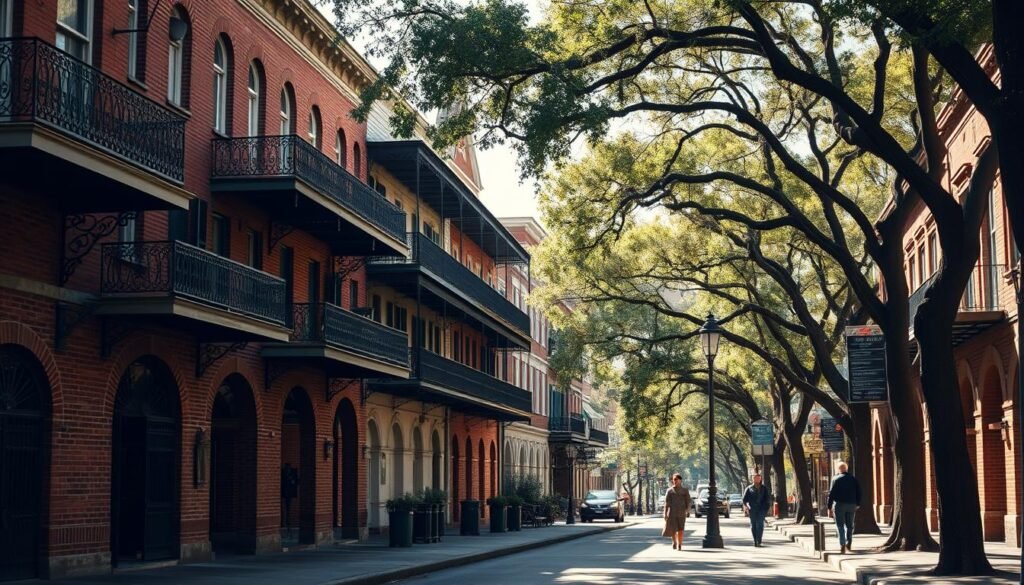
Creole Cottages: A Charming Blend
Creole cottages are a staple of New Orleans’ architectural landscape, characterized by their bright colors, ornate ironwork, and intricate woodwork. These charming homes originated in the 18th century, blending French, Spanish, and African influences. The Creole cottage style is a testament to the city’s cultural melting pot, with its unique blend of architectural elements.
One of the defining features of Creole cottages is their use of wrought iron and decorative balconies, which add a touch of elegance to the exterior. The interiors are often designed with large galleries and high ceilings to maximize ventilation and natural light, reflecting the practical needs of the city’s subtropical climate.
Greek Revival: Elegance Meets Culture
Greek Revival architecture, on the other hand, brings a touch of elegance to New Orleans’ historic homes, characterized by its use of classical elements such as columns, pilasters, and pediments. This style was particularly popular during the mid-19th century, as it symbolized the cultural and intellectual aspirations of the time.
In New Orleans, Greek Revival architecture is often adapted to the local climate, with features such as galleries and porches that provide shade and protection from the elements. The style is also notable for its use of bold colors and ornate details, which add to the overall grandeur of the buildings.
The combination of Creole cottages and Greek Revival architecture, among other styles, contributes to the rich tapestry of New Orleans’ historic landmarks. This architectural diversity is a key aspect of the city’s cultural identity, reflecting its history as a melting pot of different cultures and influences.
As we explore these iconic architectural styles, we gain a deeper understanding of the cultural and historical context that shaped them. New Orleans’ historic architecture is not just a collection of buildings; it’s a living, breathing testament to the city’s history, culture, and resilience.
The Famous French Quarter: A Testament to Time
As a cornerstone of New Orleans, the French Quarter stands as a testament to the city’s rich cultural heritage. This iconic neighborhood is renowned for its historic architecture, vibrant culture, and resilient spirit.
The French Quarter’s architecture is a captivating blend of styles, reflecting the diverse influences of its history. From the elegant Creole townhouses to the charming shotgun houses, each building tells a story of the city’s past.
Notable Buildings in the French Quarter
The French Quarter is home to numerous iconic buildings, each with its own unique history and architectural significance. Some of the most notable include:
- The Cabildo, a former Spanish government building that now serves as a museum.
- St. Louis Cathedral, a stunning example of Gothic Revival architecture.
- The Preservation Hall, dedicated to preserving traditional New Orleans jazz.
For more information on the architectural origins of the French Quarter, visit this page to explore the rich history behind its iconic buildings.
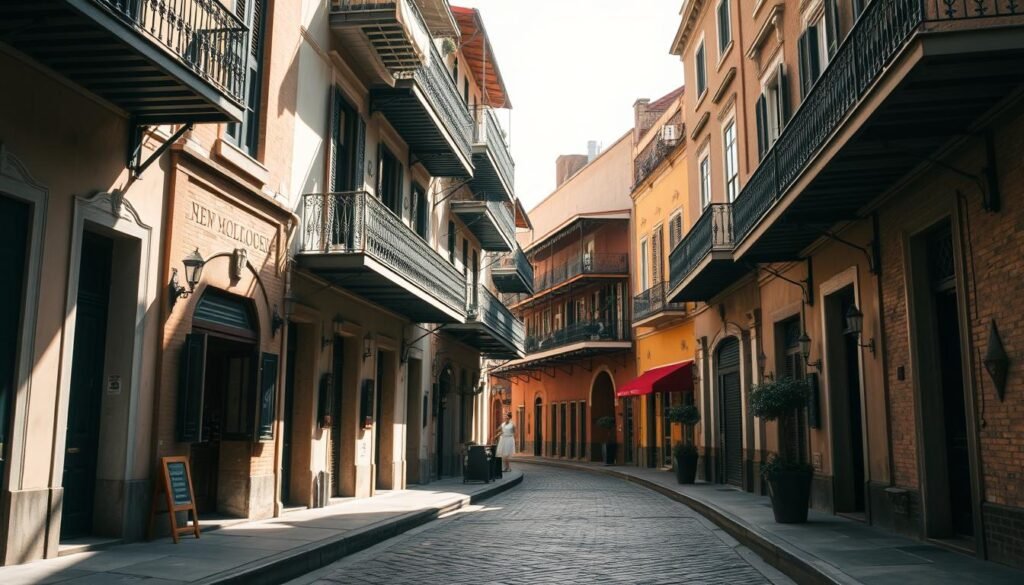
Preservation Efforts in the Quarter
Preserving the historic integrity of the French Quarter is an ongoing challenge. The city and local preservation societies work tirelessly to protect and restore the area’s iconic buildings.
“The French Quarter is not just a collection of old buildings; it’s a living, breathing testament to the city’s history and culture.”
Some of the key preservation efforts include:
| Initiative | Description |
|---|---|
| Restoration Projects | Ongoing efforts to restore historic buildings to their original glory. |
| Historic Designation | Protecting buildings and districts through historic designation. |
| Community Engagement | Educating residents and visitors about the importance of preservation. |
These efforts ensure that the French Quarter remains a vibrant and authentic part of New Orleans, celebrating its history while embracing the future.
Garden District: A Showcase of Antebellum Architecture
The Garden District stands as a testament to New Orleans’ architectural splendor, featuring some of the city’s most historic landmarks. As we explore this iconic district, we’re treated to a visual feast of grand mansions, picturesque gardens, and intricate ironwork.
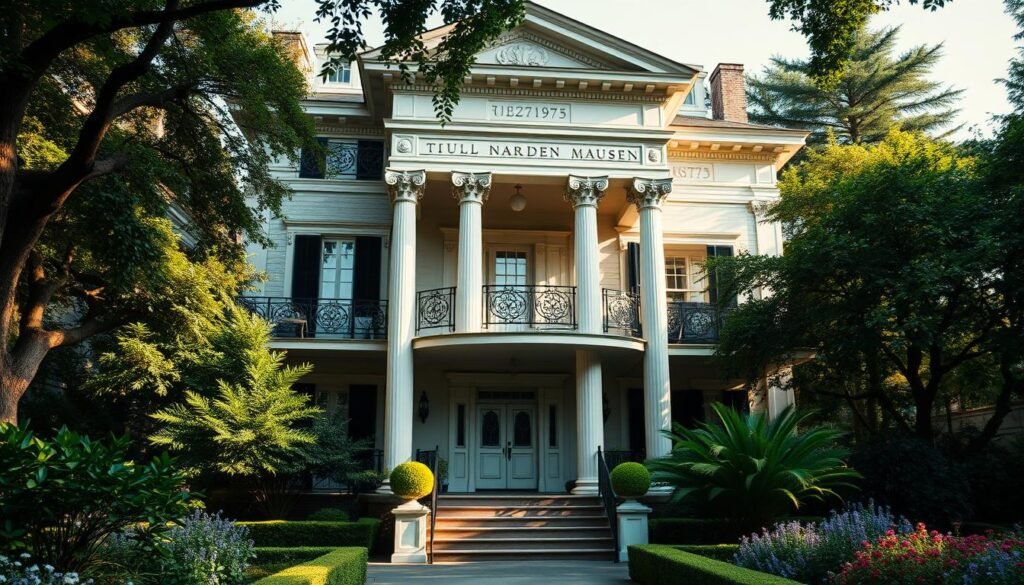
A Glimpse into Historic Homes
The Garden District is home to some of the most stunning antebellum homes in the country. These grand mansions, with their impressive facades and intricate details, offer a glimpse into the lives of the families who once resided there. As you stroll through the district, you’ll notice the unique blend of architectural styles, reflecting the cultural melting pot that is New Orleans.
Many of these historic homes have been meticulously preserved, allowing visitors to appreciate their original charm while still enjoying modern comforts. The storytelling through architecture is palpable as you walk through the district, with each home revealing a piece of the city’s rich history.
Unique Landscaping Features
One of the defining features of the Garden District is its breathtaking landscaping. The district is renowned for its iconic oak trees, which provide a canopy of shade and add to the area’s mystique. Additionally, the intricate ironwork that adorns many of the homes and fences is a hallmark of New Orleans’ architectural heritage.
The gardens themselves are a testament to the city’s floral beauty, with a variety of plants and flowers adding color and vibrancy to the landscape. As you explore the Garden District, you’ll discover how these unique landscaping features contribute to the area’s charm and character, making it a must-visit destination for anyone interested in historic landmarks in New Orleans and architectural heritage in the south.
The Significance of Historic Preservation
As a city, we’ve come to realize that preserving our historic sites is preserving our identity. New Orleans is a city like no other, with a rich history that is palpable in its architecture. The preservation of historic properties is not just about maintaining old structures; it’s about keeping our culture alive.
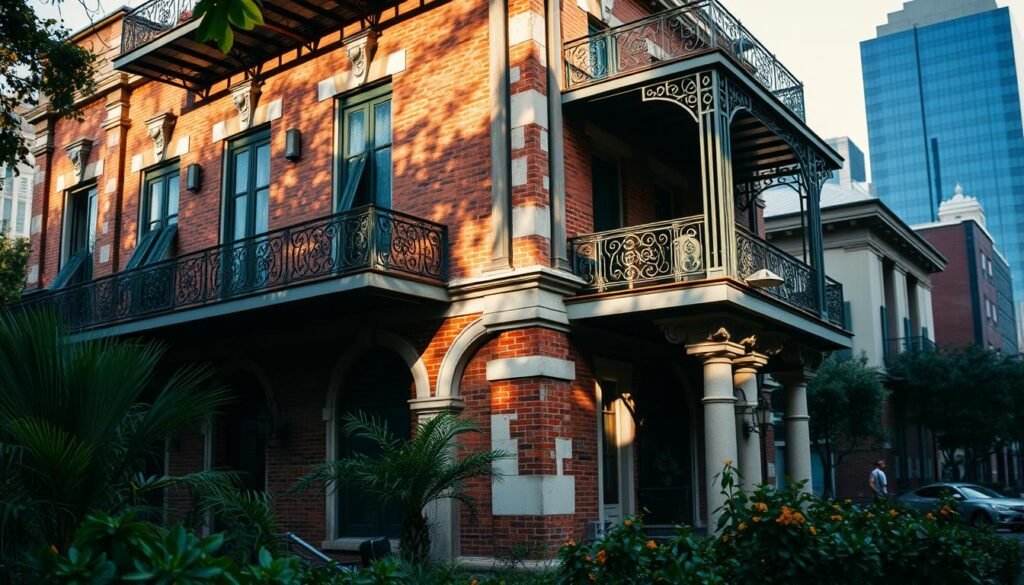
Benefits for the Community
Historic preservation efforts in New Orleans have numerous benefits for the community. For one, it boosts tourism, as visitors from all over the world come to experience the city’s unique architectural heritage. This, in turn, supports local businesses and stimulates economic growth.
- Preservation projects create jobs for local residents, both in the construction industry and in the tourism sector.
- Historic districts become vibrant cultural hubs, fostering a sense of community among residents.
- The preservation of historic buildings helps maintain the city’s character, making it a more attractive place to live and visit.
Challenges Faced by Preservationists
Despite the benefits, preservationists in New Orleans face several challenges. One of the main issues is balancing modern needs with historic preservation. As the city grows and evolves, there is increasing pressure to develop historic areas, which can lead to conflicts between preservationists and developers.
Some of the key challenges include:
- Securing funding for preservation projects, which can be costly and time-consuming.
- Navigating complex regulatory frameworks that govern historic preservation.
- Raising awareness among the public about the importance of preserving New Orleans’ historic architecture.
By understanding these challenges and working together, we can ensure that New Orleans’ historic architecture continues to thrive for generations to come.
Unique Features of New Orleans’ Historic Buildings
As you wander through the streets of New Orleans, you’ll notice the city’s historic buildings boast a range of unique features that make them truly special. These characteristics not only add to the city’s charm but also reflect its rich cultural heritage.
Wrought Iron Balconies and Their Allure
Wrought iron balconies are a hallmark of New Orleans’ architecture, particularly in the French Quarter. These intricate balconies, often adorned with delicate patterns and flowers, serve as a testament to the craftsmanship of the city’s past. They not only provide a touch of elegance to the buildings but also create a sense of continuity with the city’s history.
The use of wrought iron in balconies was influenced by European styles, particularly from Spain and France. This style became a staple in New Orleans due to the city’s historical ties with these countries. The balconies were not just decorative; they were also functional, providing shade and a space for residents to enjoy the outdoors while maintaining privacy.
Colorful Facades: A Visual Delight
Another distinctive feature of New Orleans’ historic buildings is their colorful facades. The vibrant hues used on the buildings’ exteriors contribute to the city’s lively atmosphere and are a reflection of its cultural vibrancy. From pastel shades to deeper, richer tones, the palette used in New Orleans’ architecture is both varied and striking.
The practice of painting buildings in bright colors was partly influenced by the city’s cultural heritage and partly by practical considerations. In a city prone to humidity and decay, painting buildings was a way to protect them from the elements. Over time, this practice evolved into an art form, with colors being chosen not just for durability but also for aesthetic appeal.
| Feature | Description | Cultural Influence |
|---|---|---|
| Wrought Iron Balconies | Intricate ironwork, often with floral patterns, adding elegance and functionality | European, particularly Spanish and French |
| Colorful Facades | Vibrant hues used on building exteriors, contributing to the city’s lively atmosphere | Reflects the city’s cultural vibrancy and heritage |
The combination of wrought iron balconies and colorful facades, among other features, makes New Orleans’ historic buildings truly iconic. These elements not only enhance the city’s architectural landscape but also play a significant role in its cultural identity.
The Influence of Religion on Architecture
New Orleans’ architecture is deeply intertwined with its religious heritage, reflecting the city’s diverse spiritual landscape. As a local, I’ve always been fascinated by how the city’s historic buildings tell a story of faith, with religious influences evident in its iconic landmarks.
The city’s religious architecture is not just about buildings; it’s about the community and the cultural practices that have shaped New Orleans over centuries. One of the most striking examples of this influence is the St. Louis Cathedral, located in Jackson Square.
St. Louis Cathedral: A Spiritual Landmark
St. Louis Cathedral stands as a testament to the city’s rich religious history. This beautiful cathedral, with its stunning architecture, has been a spiritual landmark for locals and visitors alike. As “a beacon of hope and faith” in the heart of the French Quarter, it continues to play a vital role in the community.
The cathedral’s design reflects the cultural and spiritual values of the community, showcasing a blend of European and local architectural styles. It’s a place where people come to worship, to reflect, and to connect with the city’s history.
Historic Churches and Their Designs
Beyond St. Louis Cathedral, New Orleans is home to numerous historic churches, each with its unique design and story. These churches are not just places of worship; they are also significant architectural landmarks that contribute to the city’s cultural heritage.
As noted by architectural historians,
“The historic churches of New Orleans are a testament to the city’s architectural diversity, reflecting the various cultural influences that have shaped the city over time.”
From the ornate details of the Catholic churches to the simplicity of some of the Protestant ones, each church tells a story of the community it serves.
The influence of religion on New Orleans’ architecture is a rich tapestry that continues to evolve, reflecting the city’s ongoing story of faith, community, and cultural identity.
Exploring Historic Districts Beyond the French Quarter
New Orleans’ historic districts, such as Marigny and Treme, showcase the city’s diverse cultural heritage beyond the French Quarter. While many visitors flock to the iconic French Quarter, these neighborhoods offer a unique glimpse into the city’s history and cultural identity.
The city’s historic preservation efforts have ensured that these districts retain their charm and character. As we explore these areas, we gain a deeper understanding of New Orleans’ historic architecture and its significance.
Marigny: A Creative Hub
Marigny is known for its vibrant arts scene, historic architecture, and eclectic mix of boutiques and restaurants. This district has become a hub for creatives, with numerous galleries and street art installations.
One of the key features of Marigny is its blend of historic and contemporary architecture. The district’s buildings reflect its history, with many structures dating back to the 19th century.
| District | Notable Features | Historic Significance |
|---|---|---|
| Marigny | Vibrant arts scene, eclectic boutiques | Blend of historic and contemporary architecture |
| Treme | Rich cultural heritage, historic homes | Oldest African American neighborhood in the United States |
Treme: The Heart of Cultural Heritage
Treme is another historic district that is steeped in cultural heritage. Known as the oldest African American neighborhood in the United States, Treme has a rich history that is reflected in its architecture and cultural institutions.
Visitors to Treme can explore historic homes, visit cultural landmarks, and experience the district’s vibrant music scene. The area is also home to numerous historical architecture tours, providing insight into its significance.
By exploring these historic districts, we can gain a deeper appreciation for New Orleans’ historic preservation efforts and the importance of maintaining the city’s cultural heritage.
Architectural Tours: An Immersive Experience
Delving into the heart of New Orleans’ architectural heritage, one can uncover the city’s soul through its buildings and structures. The city’s historic architecture is not just about buildings; it’s about the stories they tell and the history they preserve.
New Orleans offers a variety of architectural tours that cater to different interests and preferences. Whether you’re a history buff, an architecture enthusiast, or simply a curious traveler, there’s a tour designed for you.
Guided Tours vs. Self-Guided Adventures
When it comes to exploring New Orleans’ historic architecture, visitors have two primary options: guided tours and self-guided adventures. Guided tours offer the benefit of expert knowledge, providing insights into the historical context and architectural styles of the buildings. On the other hand, self-guided tours offer flexibility and the freedom to explore at one’s own pace.
Guided tours are led by knowledgeable guides who share stories and anecdotes about the city’s landmarks, such as the iconic French Quarter buildings. These tours can range from walking tours to bus tours, each offering a unique perspective on the city’s architecture.
Recommendations for Tourists
For those looking to explore New Orleans’ historic architecture, here are some recommendations:
- Consider a guided walking tour of the French Quarter to see its historic buildings up close.
- Explore the Garden District on a self-guided tour to admire its grand antebellum mansions.
- Visit during the spring or fall to enjoy mild weather and fewer crowds.
To give you a better idea of what to expect, here’s a comparison of popular architectural tours in New Orleans:
| Tour Type | Duration | Highlights |
|---|---|---|
| French Quarter Walking Tour | 2 hours | Historic buildings, Jackson Square, St. Louis Cathedral |
| Garden District Bus Tour | 1.5 hours | Antebellum mansions, celebrity homes, picturesque gardens |
| Self-Guided Audio Tour | Flexible | Major landmarks, historic districts, architectural insights |
New Orleans’ historic architecture is a treasure trove of stories, styles, and history. Whether you choose a guided tour or a self-guided adventure, you’re sure to be captivated by the city’s architectural beauty.
Future of New Orleans’ Historic Architecture
As New Orleans continues to grow and evolve, preserving its historic architecture remains a top priority. The city’s unique cultural heritage is deeply rooted in its historic buildings, making preservation efforts crucial for maintaining its identity.
Preserving the Past for the Future
Balancing modern needs with preservation is a delicate task. The city must adapt to the needs of its residents and visitors while protecting its historic properties. Historic preservation efforts in New Orleans are underway, with a focus on restoring iconic buildings and promoting sustainable development.
Innovative Approaches to Restoration
Innovative restoration projects are breathing new life into New Orleans’ historic architecture. From adaptive reuse of old buildings to cutting-edge preservation techniques, the city is finding creative ways to protect its cultural heritage. These efforts not only preserve the past but also ensure the continued relevance of New Orleans’ historic architecture in the modern world.
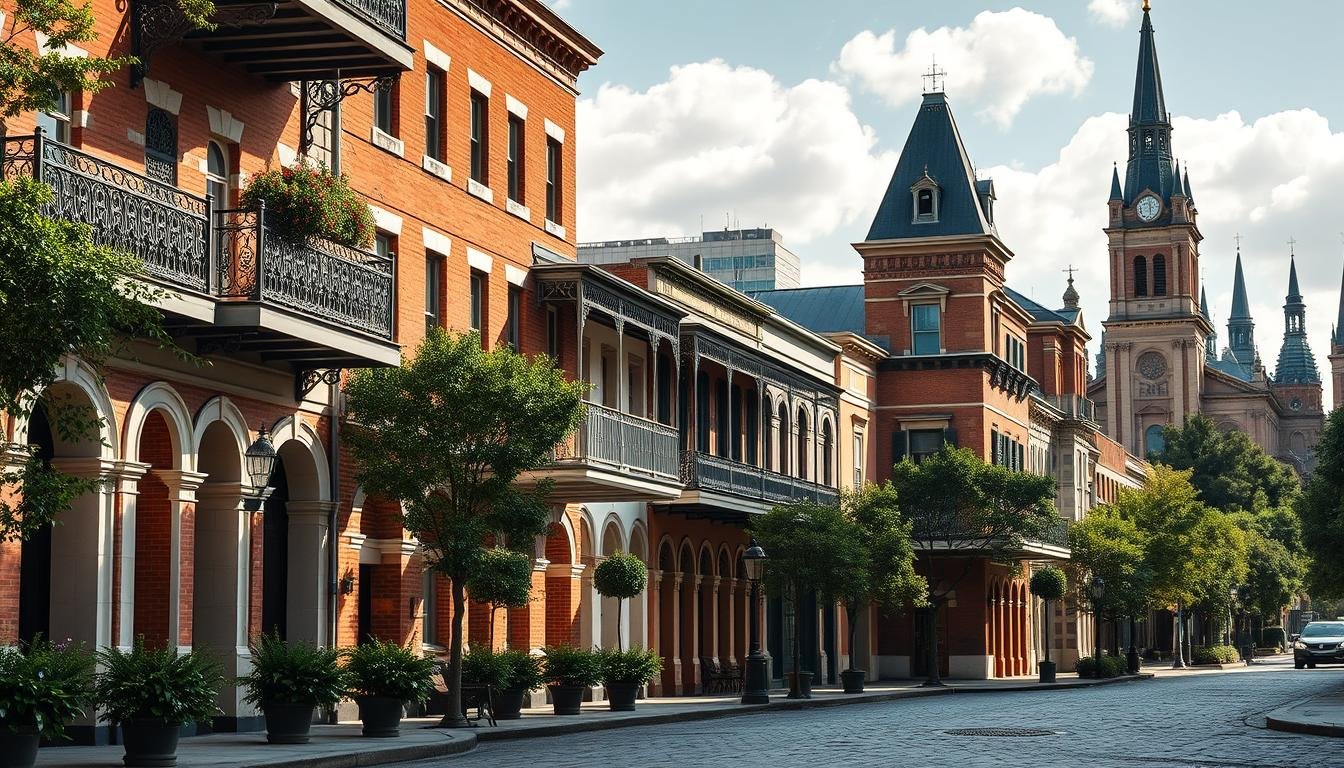
Leave a Reply